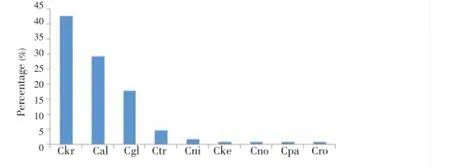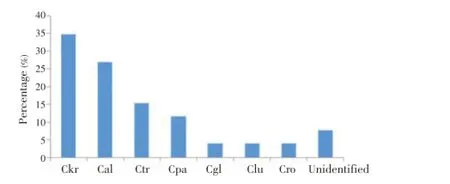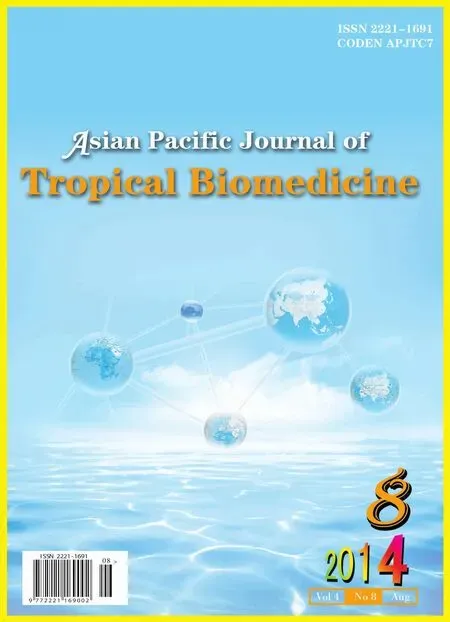Digestive fungal flora in asymptomatic subjects in Bobo-Dioulasso, Burkina Faso
Bamba Sanata, Ouédraogo Abdoul Salam, Sangaré Ibrahim, Zida Adama, Cissé Mamoudou, Karou D. Simplice, Simpore Jacques, Guiguemdé T. Robert, Hennequin Christophe
1Department of Parasitology-Mycology, University Hospital Sanou Souro, Bobo-Dioulasso, Burkina Faso
2Department of Bacteriology-Virology, Higher Institute of Health Sciences, Polytechnic University of Bobo-Dioulasso, Burkina Faso
3Faculty of Health Sciences, University of Ouagadougou, Burkina Faso
4Department of Parasitology-Mycology, Higher Institute of Health Sciences, Polytechnic University of Bobo-Dioulasso, Burkina Faso
5Biomolecular Research Center Pietro Annigoni (CERBA/LABIOGENE), Ouagadougou, Burkina Faso
6Service of Parasitology-Mycology, Saint Antoine de Paris Hospital, France
Digestive fungal flora in asymptomatic subjects in Bobo-Dioulasso, Burkina Faso
Bamba Sanata1,4, Ouédraogo Abdoul Salam2, Sangaré Ibrahim1,4, Zida Adama3, Cissé Mamoudou4, Karou D. Simplice5*, Simpore Jacques5, Guiguemdé T. Robert4, Hennequin Christophe6
1Department of Parasitology-Mycology, University Hospital Sanou Souro, Bobo-Dioulasso, Burkina Faso
2Department of Bacteriology-Virology, Higher Institute of Health Sciences, Polytechnic University of Bobo-Dioulasso, Burkina Faso
3Faculty of Health Sciences, University of Ouagadougou, Burkina Faso
4Department of Parasitology-Mycology, Higher Institute of Health Sciences, Polytechnic University of Bobo-Dioulasso, Burkina Faso
5Biomolecular Research Center Pietro Annigoni (CERBA/LABIOGENE), Ouagadougou, Burkina Faso
6Service of Parasitology-Mycology, Saint Antoine de Paris Hospital, France
PEER REVIEW
Peer reviewer
Tohru Gonoi, Professor, PhD, Division of BioResources, Medical Mycology Research Center (MMRC), Chiba Univdrsity, Chiba, Japan.
Tel: +81-43-226-2492
Fax: +82-43-226-2486
E-mail: gonoi(at)faculty.chiba-u.jp
Comments
The paper describes several Candida species and their percentages found in fecal and urine samples of asymptomatic voluntary donors in a town of Burkina Faso. The authors used MALDI-TOF MS method which is supposed to be one of the most accurate and succinct methods for identification of fungi and other microorganisms. Although the present work is performed on asymptomatic donors, the work would help in future diagnosis of patients with candidiasis.
Details on Page 661
Objective:To identify Candida species in asymptomatic subjects in Bobo-Dioulasso (Burkina Faso) by the matrix-assisted laser desorption ionization-time of flight mass spectrometry.
Candida, Mass spectrometry, Matrix-assisted laser desorption ionization-time of flight, Bobo-Dioulasso
1. Introduction
Invasive fungal infections caused byCandidaspp. remain a major cause of morbidity and mortality in the immunocompromised individuals, and more than 150 species of yeast have now been associated with human pathologies[1-3]. AlthoughCandidaalbicans(C. albicans) remained the predominant agent of nosocomial infections, an increasing number of infections are being attributed to non-albicans species, such asCandida glabrata(C. glabrata), Candida parapsilosis(C. parapsilosis), Candida tropicalis(C. tropicalis),Candida lusitaniae, andCandida krusei(C. krusei) that emerged over recent years as significant opportunistic pathogens[4,5].
Recent studies concerning the epidemiology of invasive mycoses showed a significant change in the profile ofCandidaspecies involved in human pathology[2]. Many strains ofC.albicansare still susceptible to antifungals; however species such asC. krusei, C. glabrata, Candida bracarensis, Candida nivariensis(C. nivariensis), C. parapsilosisandCandida guilliermondiihave developed intrinsic resistance to triazoles, amphotericin B or to echinocandins[6,7]. It is therefore essential to consider these changes in fungal ecology upon the therapeutic management of patients, particularly for empirical prescription.
Given the inherently variable antifungal susceptibility profiles ofCandidaspp., the correct identification of the species is often critical for efficient therapeutic decisions. The identification of the species therefore remains a crucial element in prediction of the response to antifungal treatment[8]. The mainCandidaspp. associated with human disease are readily identified by conventional mycological methods, which rely upon a combination of morphological features coupled with the abilities of the organisms to metabolize selected sugars or assimilate a variety of carbon and nitrogen sources. This requires two to five days or more in the case of uncommon species[9]. These phenotypic methods can sometimes lead to misidentification or imprecise identification, especially for species phylogenetically proximate, such asC.albicans/Candida dubliniensis,Candida inconspicua/Candida norvegensis(C. norvegensis) orC. glabrata/C. nivariensis/Candida bracarensis[9,10]. Thus, the adequate identification of these species often requires the combination of several phenotypic and molecular approaches to increase the discrimination level. The molecular approaches are based on the analysis of the genes encoding the ribosomal RNA. More recently, molecular methods, including restriction fragment length polymorphism, sequencing of internal transcribed spacer regions, multilocus sequence typing, and barcoding have been used to identify clinical and nonclinical isolates. All these methods are relatively expensive and timeconsuming[11,12]. Recent studies report the use of mass spectroscopy for the identification of yeasts as a serious alternative for conventional identification methods[13,14].
Burkina Faso is a sub Saharan country, with endemic HIV infection and fungal infections. Despite this, there is no coordination on the question of HIV and opportunistic mycoses. In the country, even though the data exist on the identification and management of therapeutics bacteria, there is limited data on fungal infections. The present study was conducted in Bobo-Dioulasso, a town located in the south-western of Burkina Faso. The main objective was to identifyCandidaspecies by matrix-assisted laser desorption ionization-time of flight (MALDI-TOF) mass spectrometry (MS) in asymptomatic individuals.
2. Materials and methods
2.1. Yeast collection strains
A cross-sectional study was conducted to collect fecal and urine samples from voluntary donors for a total period of two months in the laboratory of Parasitology-Mycology in the university hospital of Bobo-Dioulasso. The collected samples included urines and stool. Fungal strains were isolated from these samples by cultivation on Sabouraud dextrose agar and frozen in sterile water at -20 °C until used[9].
2.2. Sample preparation
Pure fungal strains from frozen stocks were obtained by 24 to 48 h incubation on BBL-CHROME agar? or CandiSelect4? or on Sabouraud medium supplemented with antibiotics[15,16]. For the MALDI-TOF assay, the on-target extraction method was used. In brief, microorganisms from a colony were applied directly to a disposable target slide using 1 μL loop[15,17]. They were lysed with 1.2 μL of 70% formic acid and dried at room temperature. Subsequently, each sample was overlaid with 1.2 μL of matrix solution, a saturated solution of α-cyano-4-hydroxycinnamic acid (CHCA), and air dried at room temperature.
The CHCA matrix co crystallized with the sample and dried on a metal plate (96-AnchorChip? spot or spots Polished Steel? 384, Bruker Daltonics) on the site of a spot. The reading of the plate was made in 24 h by MALDI-TOF system (Bruker Daltonics GmbH, Bremen, Germany).
3. Results
A total of 135 fecal samples (78.5%, 106/135) and urine (21.5%, 29/135) from voluntary donors were analyzed by the MALDI-TOF assay.Candidawas the only genus of yeast identified by the MALDI-TOF. A total of 132 samples (97.8%, 132/135) were successfully identified through direct deposit on the target. Three urine samples (2.2%, 3/135) were neither identified after direct deposit nor after complete extraction of proteins. Thus success rate of species identification in MALDI-TOF was 97.8% (132/135).
From 106 species identified from fecal samples,C. krusei(42.5%) was the most frequent followed byC.albicans(29.3%),C.glabrata(18.0%) andC.tropicalis(4.7%) (Figure 1). Uncommon species such asC.nivariensis,Candidakefyr,C. norvegensis,C.parapsilosis, andCandidarobustawere also identified.

Figure 1. Candida species identified in stools by MALDI-TOF assay.Ckr: C. krusei, Cal: C. albicans, Cgl: C. glabrata, Ctr: C. tropicalis, Cni: C. nivariensis, Cke: Candida kefyr, Cno: C. norvegensis, Cpa: C. parapsilosis, Cro: Candida robusta.
For urine, a total of 26 samples were successfully analyzed by MALDI-TOF system.C.krusei(34.6%) was the most frequent followed byC.albicans(27%),C.tropicalis(15.4%), andC. parapsilosis(Figure 2).C.glabrata,CandidalusitaniaeandCandidarobustawere the uncommon species identified from urines.

Figure 2. Candida species identified in urine by MALDI-TOF assay.Ckr: C. krusei, Cal: C. albicans, Ctr: C. tropicalis, Cpa: C. parapsilosis, Cgl: C. glabrata, Clu: Candida lusitaniae, Cro: Candida robusta.
4. Discussion
The recent evolution of epidemiology of invasive fungal infections is marked by a spectacular increase in nonalbicans species. Diversity of non-albicans species prompted biologists to develop new tools for molecular and immunological characterization of some unusual species whose identification by phenotype methods has proven difficult. More recently, MALDI-TOF MS has been proposed as alternative conventional methods[18]. The present study was designed as identifying someCandidaspecies isolated from stool and urine samples in Bobo-Dioulasso by using MALDI-TOF system. According to our results,C. kruseiprevailed in fecal samples and urine samples. Usually, this species is non-pathogenic in the absence of subjacent immunosuppression; this justifies this high prevalence in asymptomatic voluntary donors. In contrast, previous studies showed the predominance ofC.albicansin 50% of pathological samples beside the other species emerging such asC. krusei, C. glabrata, C. parapsiolosis, C. tropicalis, C. nivariensis, C. norvegensis,and others[2,4].
Candidaalbicansand most of non-albicans yeasts identified in this study such asC. krusei, C. glabrata, C. parapsiolosis, C. tropicalis, C. nivariensis, C. norvegensisare the saprophytes of the digestive tract of humans and many animals. These yeasts are opportunistic which become pathogenic under the influence of general risk factors notably, imbalance of intestinal flora after taking antibiotics or local risk factors including diabetes and deficit of immunity. Identification of these yeasts in this study corroborates their emerging nature in human fungal infections. However, the emergence requires a correct phenotypic and molecular identification for adequate therapeutic management of patients. In our context, further large-scale study in all health regions of Burkina Faso taking into account pathological samples would allow better understanding of their epidemiology.
Furthermore, the identification of some species such asC. nivariensis, C. glabrata, C. parapsilosiswhich showed intrinsic resistance to usual antifungal should be investigated for antifungal susceptibility[19]. In fact, these strains are from Bobo-Dioulasso, where the prescription of antifungals is almost inexistent compared to antibiotics which are widely prescribed against any infectious. This low usage of antifungals could give another behavior of isolates from Bobo-Dioulasso for the use of antifungal agents. The investigation for antifungal susceptibility would permit a better understanding of the susceptibility of these isolates which showed intrinsic resistance to conventional antifungal such as triazole and amphotericin[19].
Moreover, three strains (2.2%) from this study could not be identified by MALDI-TOF system. In fact, uncommon yeast species are emerging as human pathogens and their identification may pose a challenge when the type strains have not yet been included into the diagnostic databases of identification system. This can lead to misidentification of species. In addition, it is essential that databases designers provide regular updates. This update is major advantage for identification by MALDI-TOF. In fact, two common causes of identification failures may be related to the content of the database[20].
Mass spectrometry MALDI-TOF allows rapid identification of microorganisms isolated in a routine laboratory. The present study is the first conducted in Bobo-Dioulasso. Some emerging species ofCandidasuch asC. krusei, C. glabrata, C. parapsiolosis, C. tropicalis, C. nivariensis, C. norvegensis,have been recorded. These species being isolated from asymptomatic subjects could become pathogenic at any time; it is imperative to take into account the existence of these species in the therapeutic management of patients in Bobo-Dioulasso. However, further large-scale study in all health regions of Burkina Faso taking into account pathological samples would allow better understanding of the epidemiology ofCandidayeasts and establish the cartography of these species.
Conflict of interest statement
We declare that we have no conflict of interest.
Acknowledgements
Authors thank all the patients who participated in the study and all staff of Laboratory of Parasitology-Mycology, CHU Saint Antoine (Paris).
Comments
Background
Invasive infections byCandidaspp. are one of the major threads particularly for immuno-compromised patients. In candidiasis,Candida albicanshas long been a major pathogen, but clinical reports of infections of otherCandidaspecies are rapidly increasing in late years. BecausedifferentCandidaspecies show different antifungal drug susceptibility, accurate and succinct methods for species identification are required.
Research frontiers
The authors determinedCandidaspecies cultured from fecal and urine specimens corrected from asymptomatic subjects in a town of Burkina Faso, using MALDI-TOF method.
Related reports
Recent studies report the use of mass spectroscopy for the identification of yeasts as a serious alternative for conventional identification methods.
Innovations and breakthroughs
Candida kruseiand some otherCandidaspecies which are not usual main human pathogens are found in fecal and urine samples from asymptomatic voluntary donors. The authors are warning and insisting that establishment of proper and simple method for identifyingCandidaspecies are required, because susceptibility of antibiotics is different amongCandidaspecies.
Applications
Diagnosis, epidemiology, and preventive measures are applied against candidiasis. The identification of some species such asC. nivariensis,C. glabrata,C. parapsilosiswhich showed intrinsic resistance to usual antifungal should be investigated for antifungal susceptibility.
Peer review
The paper describes severalCandidaspecies and their percentages found in fecal and urine samples of asymptomatic voluntary donors in a town of Burkina Faso. The authors used MALDI-TOF MS method which is supposed to be one of the most accurate and succinct methods for identification of fungi and other microorganisms. Although the present work is performed on asymptomatic donors, the work would help in future diagnosis of patients with candidiasis.
[1] Awosika S, Olajubu F, Amusa N. Microbiological assessment of indoor air of a teaching hospital in Nigeria. Asian Pac J Trop Biomed 2012; 2: 465-468.
[2] Pfaller MA, Diekema DJ. Epidemiology of invasive candidiasis: a persistent public health problem. Clin Microbiol Rev 2007; 20: 133-163.
[3] Karou DS, Djigma F, Sagna T, Nadembega C, Zeba M, Kabre A, et al. Antimicrobial resistance of abnormal vaginal discharges microorganisms in Ouagadougou, Burkina Faso. Asian Pac J Trop Biomed 2012; 2: 294-297.
[4] Marr KA. Invasive Candida infections: the changing epidemiology. Oncology 2004; 14: 9-14.
[5] Nucci M, Marr KA. Emerging fungal diseases. Clin Infect Dis 2005; 41: 521-526.
[6] Espinel-Ingroff A. In vitro antifungal activities of anidulafungin and micafungin, licensed agents and the investigational triazole posaconazole as determined by NCCLS methods for 12,052 fungal isolates: review of the literature. Rev Iberoam Micol 2003; 20: 121-136.
[7] Miceli MH, Díaz JA, Lee SA. Emerging opportunistic yeast infections. Lancet Infect Dis 2011; 11: 142-151.
[8] Pappas PG, Rex JH, Sobel JD, Filler SG, Dismukes WE, Walsh TJ, et al. Guidelines for treatment of candidiasis. Clin Infect Dis 2004; 38: 161-189.
[9] Pincus DH, Orenga S, Chatellier S. Yeast identification-past, present, and future methods. Med Mycol 2007; 45: 97-121.
[10] Borman AM, Petch R, Linton CJ, Palmer MD, Bridge PD, Johnson EM. Candida nivariensis, an emerging pathogenic fungus with multidrug resistance to antifungal agents. J Clin Microbiol 2008; 46: 933-938.
[11] Montero CI, Shea YR, Jones PA, Harrington SM, Tooke NE, Witebsky FG, et al. Evaluation of pyrosequencing (R) technology for the identification of clinically relevant non-dematiaceous yeasts and related species. Eur J Clin Microbiol Infect Dis 2008; 27: 821-830.
[12] Seyfarth F, Ziemer M, Sayer HG, Burmester A, Erhard M, Welker M, et al. The use of ITS DNA sequence analysis and MALDI-TOF mass spectrometry in diagnosing an infection with Fusarium proliferatum. Exp Dermatol 2008; 17: 965-971.
[13] Alanio A, Beretti JL, Dauphin B, Mellado E, Quesne G, Lacroix C, et al. Matrix-assisted laser desorption ionization time-of-flight mass spectrometry for fast and accurate identification of clinically relevant Aspergillus species. Clin Microbiol Infect 2011; 17: 750-755.
[14] Stevenson LG, Drake SK, Shea YR, Zelazny AM, Murray PR. Evaluation of matrix-assisted laser desorption ionization-time of flight mass spectrometry for identification of clinically important yeast species. J Clin Microbiol 2010; 48: 3482-3486.
[15] Bader O, Weig M, Taverne-Ghadwal L, Lugert R, Gross U, Kuhns M. Improved clinical laboratory identification of human pathogenic yeasts by matrix-assisted laser desorption ionization time-of-flight mass spectrometry. Clin Microbiol Infect 2011; 17: 1359-1365.
[16] Sendid B, Ducoroy P, Francois N, Lucchi G, Spinali S, Vagner O, et al. Evaluation of MALDI-TOF mass spectrometry for the identification of medically-important yeasts in the clinical laboratories of Dijon and Lille hospitals. Med Mycol 2013; 51: 25-32.
[17] Bille E, Dauphin B, Leto J, Bougnoux ME, Beretti JL, Lotz A, et al. MALDI-TOF MS Andromas strategy for the routine identification of bacteria, mycobacteria, yeasts, Aspergillus spp. and positive blood cultures. Clin Microbiol Infect 2012; 18: 1117-1125.
[18] Claydon MA, Davey SN, Edwards-Jones V, Gordon DB. The rapid identification of intact microorganisms using mass spectrometry. Nat Biotechnol 1996; 14: 1584-1586.
[19] Borman AM, Petch R, Linton CJ, Palmer MD, Bridge PD, Johnson EM. Candida nivariensis, an emerging pathogenic fungus with multidrug resistance to antifungal agents. J Clin Microbiol 2008; 46: 933-938.
[20] Veloo AC, Welling GW, Degener JE. The identification of anaerobic bacteria using MALDI-TOF MS. Anaerobe 2011; 17: 211-212.
10.12980/APJTB.4.201414B27
*Corresponding author: Karou D. Simplice, Centre de Recherche Biomoléculaire Pietro Annigoni (CERBA/LABIOGENE), Ouagadougou, Burkina Faso.
E-mail: simplicekaou@hotmail.com
Article history:
Received 4 May 2014
Received in revised form 17 May, 2nd revised form 23 May, 3rd revised form 29 May 2014
Accepted 15 Jul 2014
Available online 28 Aug 2014
Methods:A cross-sectional study was conducted from January to February 2013 in Bobo-Dioulasso to collect fecal and urine specimens from voluntary donors. Fungal strains were isolated on Sabouraud dextrose agar and analyzed using matrix-assisted laser desorption ionisationtime-of-flight mass spectrometry.
Results:A total of 135 samples including stools (78.5%, 106/135) and urine (21.5%, 29/135) were analyzed. The results revealed that fecal specimens contained mainly Candida krusei (C. krusei) (42.5%) followed by Candida albicans (29.3%), Candida glabrata (18.0%) and Candida tropicalis (C. tropicalis) (4.7%). C. krusei (34.6%) was also found to be the most frequently identified in urine samples followed by Candida albicans (27.0%), C. tropicalis (15.4%) and Candida parapsilosis. However, uncommon species such as Candida nivariensis, Candida kefyr, Candida norvegensis, Candida parapsilosis, Candida lusitaniae and Candida robusta were also identified from fecal and urines samples.
Conclusions:This study noted the emergence of species such as C. krusei, Candida glabrata, Candida parapsiolosis, C. tropicalis, Candida nivariensis, Candida norvegensis, and others. It is an imperative to take into account the existence of these species in the therapeutic management of patients in Bobo-Dioulasso.
 Asian Pacific Journal of Tropical Biomedicine2014年8期
Asian Pacific Journal of Tropical Biomedicine2014年8期
- Asian Pacific Journal of Tropical Biomedicine的其它文章
- Adult Klebsiella pneumoniae meningitis in Qatar: clinical pattern of ten cases
- Iron-chelating and anti-lipid peroxidation properties of 1-(N-acetyl-6-aminohexyl)-3-hydroxy-2-methylpyridin-4-one (CM1) in longterm iron loading β-thalassemic mice
- Glucose-6-phosphate dehydrogenase (G6PD) deficiency is associated with asymptomatic malaria in a rural community in Burkina Faso
- GC/GCMS analysis of the petroleum ether and dichloromethane extracts of Moringa oleifera roots
- An efficient method in breaking of dormancy from Bunium persicum (Boiss) Fedtsch seeds: a valuable herb of Middle East and Central Asia
- Physico-chemical analysis and antimicrobial potential of Apis dorsata, Apis mellifera and Ziziphus jujube honey samples from Pakistan
